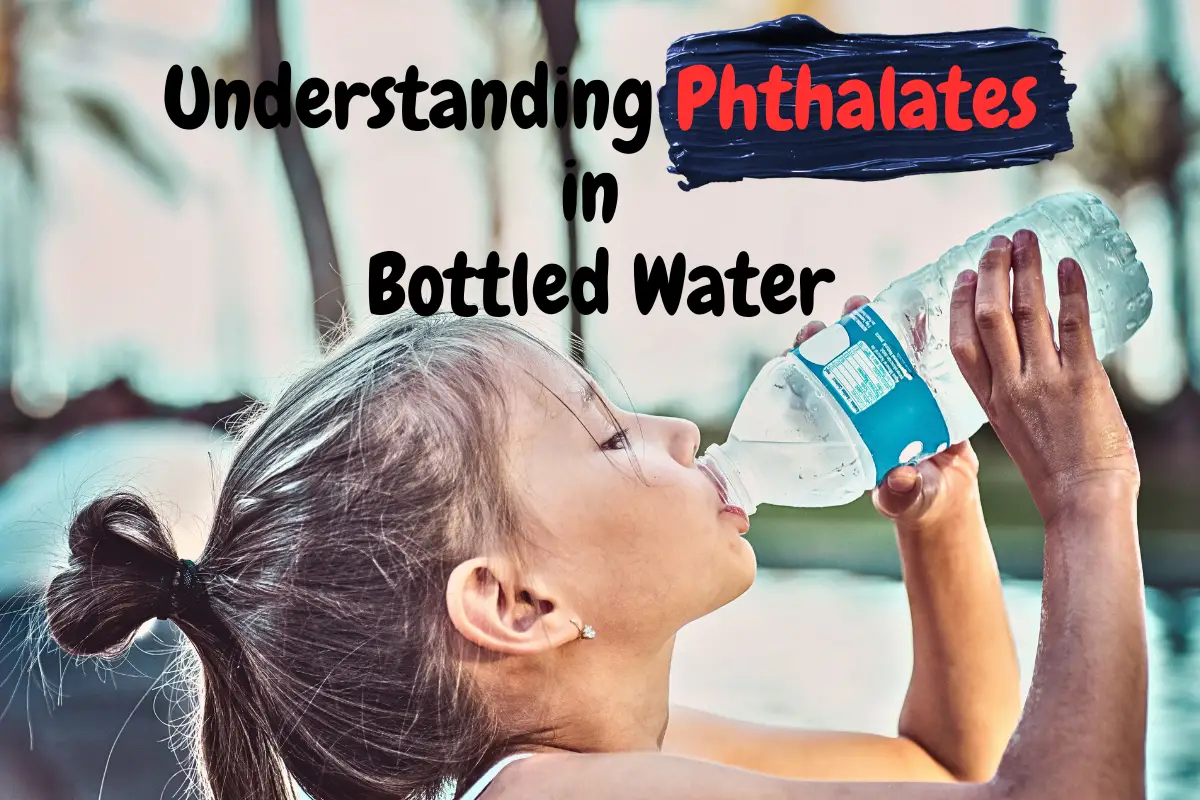Bottled water has become as common as smartphones. However, in recent years, a shadow has been cast over these crystal-clear bottles – phthalates.
Many water bottles are made from PET that are phthalate-free. However, phthalates can be found in bottled water when they are made from recycled plastics, although at very low concentrations. In some countries outside the U.S, phthalate levels exceed the U.S FDA limit. Phthalates are more likely to leach from plastic into water when bottles are reused, or exposed to high temperatures or sunlight.
It’s great news that most of our water is phthalate-free, but there are some situations that can help phthalates enter our water. This article explains what those situations are and how to avoid them, and everything else you need to know about phthalates in bottled water.
Phthalates In Our Bottled Water

Phthalates, often mentioned in the same breath as PVC plastic, have flexed their chemical muscles in a range of products for more than forty years. Phthalates give our plastics flexibility – think of them as yoga gurus for materials, allowing them to bend without breaking. From the shingles on your roof to the shower curtain that sticks to your leg, phthalates are there.
But these chemicals have recently found themselves in the hot seat, accused being harmful to our health. Despite the green signal from agencies like the FDA, there is continued debate around risks associated with phthalate exposure.
Bottled Water
Here’s the clincher though—your plastic water bottle, usually made of polyethylene terephthalate (PET), is not full of phthalates. Contrary to the confusion due to their names, PET (PolyEthylene Terephthalate) and phthalates are not the same. They don’t share the same molecular lounge, and PET doesn’t need phthalates to be flexible.
So, the water bottle you left in your car? Most likely phthalate-free.
The one you tote to the gym? Also probably phthalate-free.
Invisible Phthalates in Water
Even though PET isn’t a phthalate, many PET bottles are created from recycled plastic or use phthalates as a plasticizer. When the recycled plastic contains phthalates then some residual phthalates are then incorporated in the new water bottle.
In this scenario, phthalates can then sneak into your water from the recycled plastic bottle under certain environmental conditions – think a hot car’s interior or a sunbathed porch.
Thankfully, the amount of phthalates found in bottled water in the U.S. is very low, and almost always below the FDA’s limit of 6 μg/L. This includes most phthalates of concern:
- benzyl butyl phthalate (BBP)
- dibutyl phthalate (DBP)
- di-2-(ethylhexyl) phthalate (DEHP)
- diethyl phthalate (DEP)
- dimethyl phthalate (DMP)
Unfortunately other countries are not so lucky. Global water analysis studies have uncovered that bottled water from several countries contains phthalates at levels that raise eyebrows—sometimes even at concentrations higher than the regulatory limits set by the FDA and WHO.
Unwanted Side Effects
Phthalates may cause:
- Endocrine disruption.
- Reproductive issues
- Developmental problems
However, you need to be ingesting large amounts of phthalates to experience these effects. And certainly not the amount found in bottled water. If you’re truly concerned about phthalates in your bottled water there are two options:
- Purchase new water bottles, drink them immediately (don’t store them for long periods) and then discard the bottle – although this option is far from environmentally friendly.
- Invest in a reusable, metal water bottle that you can refill with clean drinking water. Be wary of bottles with plastic seals, straws etc that can also contain phthalates.
PET Bottles: The Carrier Not the Culprit
PET, despite being wrongfully accused of harboring phthalates, does come with its warnings.
The best way to guarantee your bottled water stays as pure as nature intended is to store it properly – cool, dark, and phthalate-free. Avoiding heat and direct sunlight is the best option to avoid phthalates in your water.
When it comes to reusing those PET bottles, it’s a noble thought shadowed by practicality. Repeated use can lead to degradation, and no one wants their water tasting like a chemistry lab.
How To Lower Your Phthalate Exposure Risk
You can reduce the risk of being exposed to phthalates by controlling the following:
Reusing Plastic Bottles
Reusing our water bottles might make us feel like we are doing good by the environment, but in reality it’s probably the fastest way for phthalates to enter your drinking water. Avoid reusing a plastic water bottle, instead invest in a reusable metal one.
Acidity and pH Values
The more acidic the water is the more likely phthalates will leach into your water. Most purified bottled water is more acidic than spring or mineral water. Opt for a more alkaline brand of water to improve the pH of your bottled water.
You can find brands of alkaline water available here, or if you prefer spring water you can read more about those brands here.
High Temperatures
Any phthalates in your bottle are more likely to leach into the water under high temperatures. Always make sure your bottle is stored out of direct sun, and preferably somewhere cool. Ideally, never leave a water bottle in your car.
Long-Term storage
The longer water stays inside your bottle, the more likely phthalates are going to leach into it. Plastic like any other material, degrades over time increasing the likelihood of phthalates entering your water – especially if it comes from recycled plastic. Avoid bulk-buying and stocking up on water (unless it’s storm season of course), and try to drink the water close to the purchase date.
Exposure to Sunlight
Exposing bottled water to direct sunshine is one of the biggest ways to increase the risk of phthalates leaching into your water. Sunlight increases the speed that plastics decompose, encouraging those pesky phthaltes to move like nothing else. Remember to keep your bottle in a cool, dark place.
